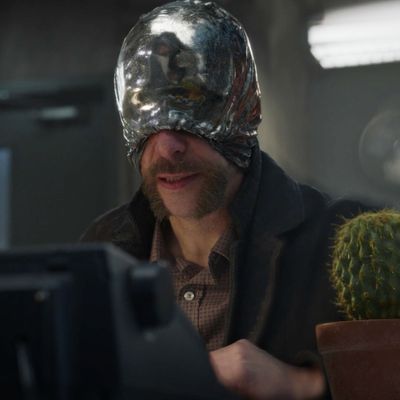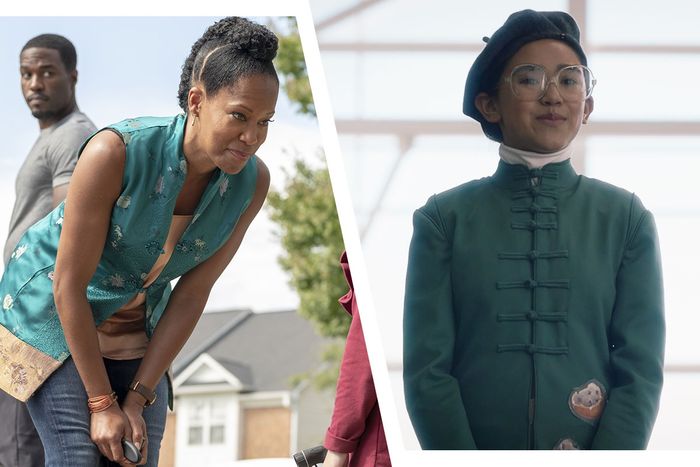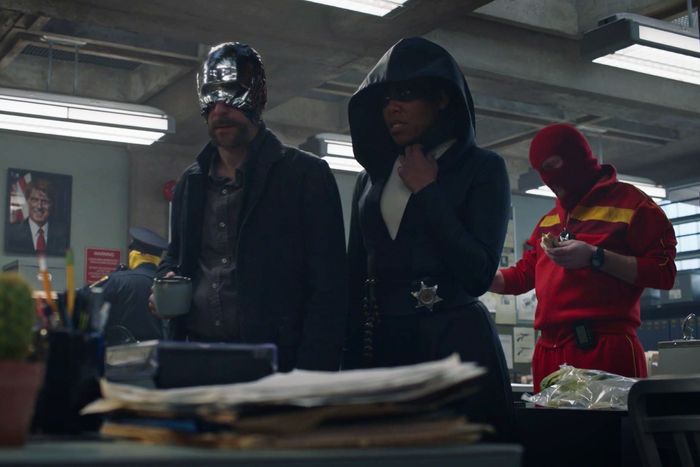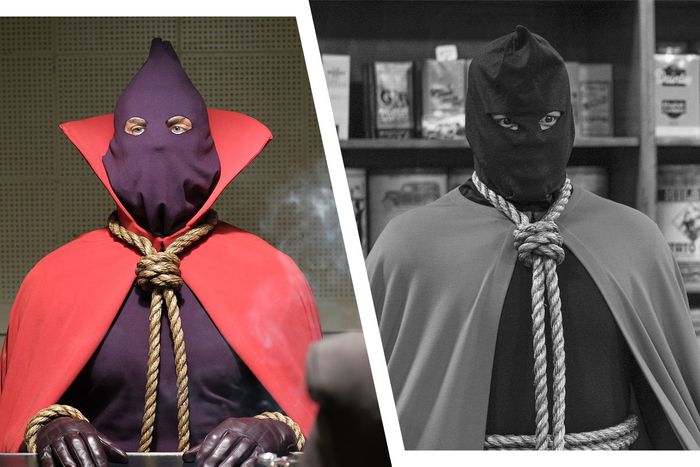
Watchmen is a story about history. It’s also a story about giant squids and a blue man who lives on Mars, but mostly it’s about history. Its narrative spans almost a century, touching on events unknown by some, like the Tulsa massacre, and events familiar to us but with different outcomes from our own history, like the Vietnam War. Its characters reckon with a past that’s at once inspirational, painful, and forgotten by those who would like to pretend that it never occurred.
But just as it does every other part of our culture, the past has an impact on the how and why of our clothing; it can live on in something as simple as the ticket pocket that now sits unused on so many suit jackets, a vestige of a time before rideshare apps and electronic fares. The histories of our hometowns, our countries, and our world at large are laced through the pieces that we put on our backs, but perhaps what most influences our clothing is the ways in which those broader histories connect to our personal ones. In the Watchmen costume-design work of Meghan Kasperlik, we can see how all of those historical threads, the small and close as well as the universal, come together to aid, but never overwhelm, a story that brings to light some of those moments previously hidden away.
“I think the research is the most exciting part of it, because you are really going back and learning about history and what people were doing,” says Kasperlik. “I really like to take little details and little moments that I’m finding not only within the costumes but what was happening in their houses and what their professions were.” It’s that sort of attention to small details — a flash of a print, a fabric choice, a specific hue — that help bring this layered story to life.
Kasperlik was drawn to Damon Lindelof’s HBO adaptation of Watchmen because she had worked on a few other projects in the superhero realm as an assistant and knew this world would be “complex and interesting,” but she never imagined that “the story would be what the story is of our Watchmen.” Her work throughout builds on the costume-design work of Sharen Davis in the pilot, which included the sleek look of Sister Night, to further build out this fascinating world that looks like our own while also being alien in many ways.
One of the ways Watchmen expands its world beyond our own reality is through a history that diverges from our own, as in the Vietnamese influences that are a result of the war ending in 1971 and the country being annexed as the 51st state. At the same time, the costuming shows how the same historical moment can differently affect the clothing of different characters. For both Lady Trieu and Angela, Vietnam is the place of their birth, but the ways in which they relate to that place, the ways in which they honor it, play differently through their costumes.
Angela has a connection to Vietnam as the place of her birth and where she met her husband, Calvin, but how that history weaves its way into her clothing is more subtle. Of course, we see it very strongly in our introduction to Angela in the pilot, in one of the costumes designed by Davis; there she is telling a classroom of children a story directly related to that history, and her outfit feels almost as much as a costume as when she is dressed as Sister Night. But in her day-to-day life, far removed from Vietnam, that past is quieter. When Kasperlik came onto the project, she looked for ways to more subtly acknowledge Angela’s history, presenting Regina King with options reflecting “elements not only of Vietnamese culture, but also African-American culture, and adding in little prints or little details without making it the entire story of the character.”
With Lady Trieu and her daughter, Bian, however, Kasperlik explains that because they have a more recent connection to Vietnam than Angela, the country’s influence comes through much more strongly. Notably for a story that is also very much about how the past echoes through generations, we see it most explicitly not in Lady Trieu’s clothing, but in that of her daughter. Kasperlik often kept Bian “in more of an áo dài,” a traditional Vietnamese costume. Upon Lady Trieu’s first meeting with Angela, she tells the other woman, “On her deathbed, my mother made me promise I would never leave Vietnam, so I found a loophole. Now Vietnam never leaves me.” She is speaking in that moment specifically about the vivarium in which the women are speaking, but in the clothing of Bian we can see another, more subtle manifestation of how Lady Trieu has taken her past with her to Oklahoma and how she is, in a very literal way, passing it on to her child.
While clothing like that of Lady Trieu and Bian can serve to showcase the parts of our past we want to celebrate, for other characters that occupy this world, clothing serves as a sort of protection from the trauma of the past. In the opening of episode five, we view the destruction of New York City through the eyes of a young Wade, who experiences a traumatic personal humiliation mere moments before witnessing the horror of the extradimensional squid unleashed on the world by Adrian Veidt as a weapon of mass destruction. And with that glipse into Looking Glass’s past, we are given a deeper understanding of the ways in which he has been using his clothing to shield himself.
This shielding takes its most literal form in Looking Glass’s reflective mask, which protects him from the lingering psychic blasts of the squid incident. Kasperlik explains that while the mask effect was mostly CG, “We had a lamé mask, like a spandex lamé, when the CG element didn’t need to happen.” But the mask isn’t the only piece of Looking Glass’s look that has its roots in the historical thread that opens episode five. His detective look is closer to what one might expect of a character in a police procedural, unlike the more slapped-together, masked-vigilante looks of Red Scare and Pirate Jenny, or the sleek look of Sister Night. “It’s Wade’s interpretation of what a ‘cool’ detective would look like, so his colors are slightly darker,” Kasperlik explains. It’s an understandable reaction on his part to being stripped bare and made a fool of all those years ago: His mask physically protects him from the continuing psychic blasts experienced by survivors of 11/2, while this somewhat underwhelming reach for a Cool-Detective persona is a balm to that more emotional hurt.
All of these types of histories — the deeply painful, the complicatedly heroic, the seemingly insignificant — come together in episode six, when Hooded Justice, a character from Alan Moore and David Gibbons’s graphic novel who has never been unmasked, is revealed to us as the most obvious example of Laurie Blake’s observation from episode four, that masks are protection from pain.
When I’m watching a show like this one, one with so many interlocking pieces, I can’t help but look for connections everywhere, and I thought I saw one, a straight line from Bass Reeves, the Black Marshal of Oklahoma whom Will Reeves loved as a child, to Hooded Justice, to Sister Night. But when I asked Kasperlik about it, she reminded me that the costuming of Bass Reeves and Sister Night, as characters specific to the series, had been part of Davis’s work for the pilot, and that while the specifics of Hooded Justice’s history and personal pain were created for the series, his costume’s roots lie the graphic novel.
“For the original characters, it was really important that we stay true to the graphic novel,” Kasperlik says. “In the [2009] film, they heightened everything in a different direction, but it was more about going back to those original characters and making sure that they almost jumped off the page.”
Prior to episode six, our primary exposure to Hooded Justice and other figures from the graphic novel came via the show within the show, American Hero Story. We watched a color-saturated deli scene with Topher and Calvin in episode two; we saw lovers Hooded Justice and Captain Metropolis reflected in Looking Glass’s mask as he sat in a dreary robe eating his dinner in episode five. And before both the audience and Angela are thrown back into the black-and-white past of Will Reeves in episode six, we get an alternate telling of Hooded Justice’s origin story that whitewashes the past in significant ways.
Kasperlik notes that “we collectively, as a production, wanted to make sure creatively that [American Hero Story] was heightened … the lights are brighter, the colors would pop more. Everything was a little more, as you say, cartoonish.” That approach extends to the version of Hooded Justice’s costume we see via AHS in those opening moments of episode six. “Because Hooded Justice’s costume has such a simple line, I wanted to make sure that there was a little bit of texture in there, but that it didn’t overpower the simplicity of what needed to be and really the statement of having it be so simple.”
The heightened simplicity of this version of Hooded Justice makes it all the more powerful when Will Reeves decides to don the literal remnants of his trauma — the hood used to cover his face as he was spirited away and the pieces of the ropes used to bind and hang him — in order to deal with the painful history that is eating away at him. The noose and the hood exist in the world of the graphic novel and the still-unknown Hooded Justice who resides there, but here in this Watchmen, the costume’s true significance is once that can’t be simplified, and can’t be separated from the pain of the person who wears it.




